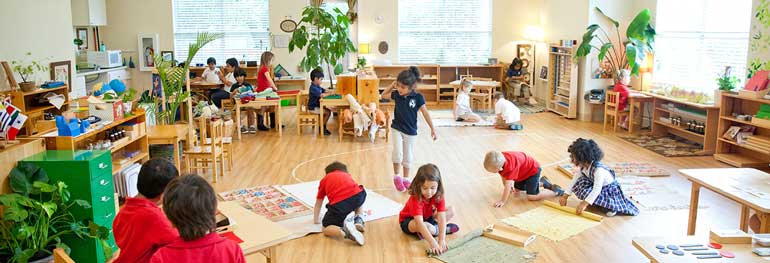Suprised to see such reference to a business? You will be more when you discover that pedagogical rules created by a first woman-doctor help to teach your employees to be more responsible, increase productivity, happiness and bring more value to your organization. .
If you are a parent, you must have heard about Marrie Montessori and her approach. Likewise, if you are interested in learning or education. Otherwise, please take a look at a detailed Wikipedia entry, and let's get to the point. Her approach is based on the fact that each kid is unique and should develop according to an individual needs.
The method is based on getting individual experiences in a fun and structured way. It let kids fluently go from playing to working on a task. Education is based on natural reactions, observations and discovering the surrounding world it not only by logic but also by instincts and emotions. It’s based on freedom and driven by kids' curiosity. Curiosity stimulates their feelings, gives satisfaction, and encourages engagement to achieve success.
Doctor Montessori developed a set of pedagogical rules, which are the foundation of her method.
Migrate to secure hosting
Don't waste your time on Redmine maintenance. Hire experts and focus on your projects
1) Teach freedom and independence
In the carefully prepared environment (classroom) kids can choose what they are most interested in, the most suitable time to engage in the exercise and the level of difficulty. They can select a partner for the activity if they wish. The teacher doesn't impose those elements on the kid. Instead, tutor takes the role of a coach, whose main responsibility is not to train someone, but arrange environment and processes in such a way that would maximize the results. Thanks to such approach, kids take part in decisions that shape their education process. This enables them to learn how to use the freedom. And gives foundation for responsibility for their development.
2) Choose what interest you
In a classroom, all materials are always available, placed thematically on the shelves, in the reach of the kid’s hand. Kid decides which element it wants to choose.

3) Work where you want
Classroom is designed more as a workshop than playground-room. It has small corners for discussion, exercises, play, library, education materials and so on. The materials lead kid from a concrete subject to abstract idea, from easier to tougher topics. There are free zones for work, assigned to categories of activities. Kid can work freely and isn't appointed to one spot.
4) Work when you want
Kids decide when they want to work, based on their feelings and current ability to focus on something.
5) Work in the form you want
The introductory lesson is always done separately with the kid to show and teach the basics. Then it can start to work independently. A kid knows that it can work in silence and no-one will interrupt the action, and won’t help unless it will be necessary. It learns and knows that it independently have chosen the tasks, and work when it wants, and for as long as it will be attractive and exciting.
6) Keep order
One of the most crucial rule. Order in surrounding makes an order in the mind and heart. Each object in the classroom has its place, and taken have to be returned there. Also, each person has its role and know their responsibilities.
Migrate to secure hosting
Don't waste your time on Redmine maintenance. Hire experts and focus on your projects
7) Obey the rules
For me, one of the most interesting is the fact that Montessori's approach is non-imposing and non-repressing. Yet it's not a stress-less method. Kids are treated as partners, and can use freedom, as longs as it does not disturb others. But. They cannot just do what they want. Set of possible activities, interactions is purposely designed by teachers, and all take place in a controlled and prepared environment. Everything is specified by rules and restrictions and under supervision.

8) Difficulties grow step by step
A kid is working on an element designed to learn a particular topic. For example, the kid works with a pink tower to learn basic concepts of sizes and relativity: such as big-small, bigger than-smaller than, small-smaller-smallest, big-bigger-the biggest. It can use the tower itself and count on a teacher's help who knows how and when to help.
But. A kid is not learning about anything other than sizes, as there are other materials for those subject.
9) Apply what you learn in practise
Montessori's material is comprehensive and interconnected. Each element is a link logically connected into a chain. Each link contains features of a material/topic from the previous one and one new. Kid applies the knowledge, skills or competencies in practise, via exercises and cooperation.
10) Show self-initiative
The kid drives its education process through its initiative, and learn new things and skills according to its interest and capabilities.
11) Do a self-check
Each task is prepared in a way that allows to independently check if it was finished correctly. And if not, to observe where the mistake was made and how to fix it.
How to apply Montessori's rules in business environment?
Primary goal to apply rule in work teams is “help me do this by myself”. Don't be a parent to your employees. Neither be a dictator. Treat your employees as partners, with freedom and responsibility.
They should be able to hold themselves accountable to easily catch if they made a mistake, learn a lesson and fix an error. By embracing human tendency to learn through action, you allow your employees to gain responsibility and forge it to professionalism. Give them a goal to reach and leave them with freedom to choose a way and methods to achieve it. Treat them as captain on the ships. Tell them to which port to reach, but let them sail the sea their way. Then settle the results.

Let's hear the quote attributed to Antoine de Saint-Exupéry.
If you want to build a ship, do not divide the men into teams and send them to the forest to cut wood. Instead, teach them to long for the vast and endless sea.
Prepare your office and work environment, to adapt and implement the rules. If it's possible, for younger employees, isolate and gradually grow difficulties. As long as you don't have a team of A players who can adjust momentarily and learn on the go, let your employees increasingly adapt to difficulties and responsibility. Let them focus on one problem to solve at the time.
In Montessori's approach engagement is adaptive. It depends on the needs, skills and activeness of the kid. Primary goal is to help grow individual set of skills and shape character. Teacher achieves it by supporting the kid in reaching concentration, increasing independence, and self-belief, cultivating a love for order and work, developing love to an individual work. Take similar approach for your employees.
Developing obedience based not on imposed instructions, but on free decisions. Mentor is helping kid to become independent from external rewards, developing attitude of mutual help without egoistical rivalry, love to environment.
Applying freedom paired with accountability makes your employees more productive, happier and more engaged. You let them be more independent and feel more how they contribute to the team. Especially if you work with millennials, that wants to have an impact on their work.

Few organizational ideas for consideration
Each step of the development process has to be carefully explained and documented. It should be absolutely clear what is each person role and responsibilities is. Also, that would cover how to behave in each possible scenario. For example, if a task is urgent, if it's complicated or if the assignment is unclear. Have clear rules about the order of work, and communication, as well as for accepted and unaccepted behaviors. Set clear standards for tracking and billing work-time and measures of personal effectiveness.
Migrate to secure hosting
Don't waste your time on Redmine maintenance. Hire experts and focus on your projects
Allow your developers to select the tasks that are most interesting to them, from a pre-selected backlog or pool of assignments.
Let your employees work in their desired conditions and time (in a reasonable border). Some people are more active in the evening or even at night. Another work better in the morning. Some prefer to work from home, or in a quiet zone, some love to feel the team spirit. Your office environment should allow people to work both individually in peace and as a team. Prepare a separate rest zone that would allow people to re-focus and re-activate during the day.
Final words
The proposed method is not a replacement for any project management methodology, but a human supplement to making work more enjoyable, fulfilling, and most importantly—more effective. It let you employees deliver your projects and learn new skills along with their interest at the same time. Still, you are in control.
Photo credits: American Montessori Society, Sapientia Montessori School, Pexels.com


